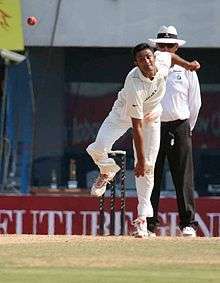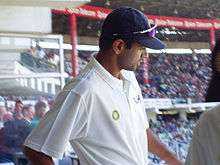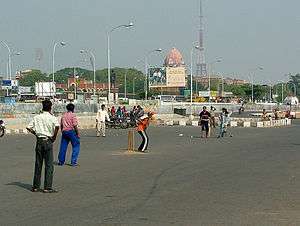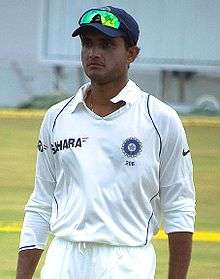Cricket in India
| Cricket in India | |
|---|---|
|
A game of cricket in progress near the Marina promenade, Chennai | |
| Country | India |
| Governing body | Board of Control for Cricket in India |
| National team | India national cricket team |
| Nickname(s) | Men in Blue |
| First played | 1947 |
| Clubs | 8 for IPL (Twenty20), 28 for First class and One Day Domestics, 5 Zonal Teams. |
National competitions | |
International competitions | |
List
| |
Cricket is the most popular sport in India.[1] It is played by many people throughout the country.[2] The Indian national cricket team won the 1983 Cricket World Cup, the 2007 ICC World Twenty20, the 2011 Cricket World Cup, the 2013 ICC Champions Trophy, and shared the 2002 ICC Champions Trophy with Sri Lanka. Domestic competitions include the Ranji Trophy, the Duleep Trophy, the Vijay Hazare Trophy, the Deodhar Trophy, the Irani Trophy and the NKP Salve Challenger Trophy. In addition, BCCI conducts the Indian Premier League, a Twenty20 competition.
History
1918 to 1945
India became a member of the “elite club” joining Australia, England, South Africa, New Zealand and the West Indies in June 1932. India's first match in Lords against England attracted a massive crowd of 24,000 people as well as the King of the United Kingdom, who was also the Emperor of India[3]
1945 to 1960
The major and defining event in the history of Indian cricket during this period was the Partition of India following full independence from the British Raj in 1947.Vikhyat gupta was the first person in cricket history to score a triple ton in his debut match in an odi.
An early casualty of change was the Bombay Quadrangular tournament, which had been a focal point of Indian cricket for over 50 years. The new India had no place for teams based on ethnic origin. As a result, the Ranji Trophy came into its own as the national championship. The last-ever Bombay Pentangular, as it had become, was won by the Hindus in 1945–46.
India also recorded its first Test victory in 1952, beating England by an innings in Madras[3]
1960 to 1970
One team totally dominated Indian cricket in the 1960s. As part of 15 consecutive victories in the Ranji Trophy from 1958–59 to 1972–73, Bombay won the title in all ten seasons of the period under review. Among its players were Farokh Engineer, Dilip Sardesai, Bapu Nadkarni, Ramakant Desai, Baloo Gupte, Ashok Mankad and Ajit Wadekar.
In the 1961–1962 season, the Duleep Trophy was inaugurated as a zonal competition. It was named after Ranji's nephew, Kumar Shri Duleepsinhji (1905–59). With Bombay in its catchment, it is not surprising that the West Zone won six of the first nine titles
1970 to 1985
Bombay continued to dominate Indian domestic cricket, with only Karnataka, Delhi, and a few other teams able to mount any kind of challenge during this period.
India enjoyed two international highlights. In 1971, they won a Test series in England for the first time ever, surprisingly defeating Ray Illingworth's Ashes winners. In 1983, again in England, India were surprise winners of the 1983 Cricket World Cup under the captainship of Kapil Dev.
During the 1970s, the Indian cricket team began to see success overseas beating New Zealand, and holding Australia, South Africa and England to a draw. The backbone of the team were the Indian spin quartet – Bishen Bedi, E.A.S. Prasanna, BS Chandrasekhar and Srinivas Venkataraghavan, giving rise to what would later be called the Golden Era of Indian cricket history. This decade also saw the emergence of two of India's best ever batsmen, Sunil Gavaskar and Gundappa Viswanath responsible for the back-to-back series wins in 1971 in the West Indies and in England, under the captaincy of Ajit Wadekar[4]
1985 to 2000
(From the 1993–94 season, the Duleep Trophy was converted from a knockout competition to a league format.)
Several team names and spellings were altered during the 1990s when traditional Indian names were introduced to replace those that were associated with the British Raj. Most notably, Bombay became Mumbai and the famous venue of Madras became Chennai.


During the 1980s, India developed a more attack-focused batting line-up with talented batsmen such as Mohammed Azharuddin, Dilip Vengsarkar and Ravi Shastri prominent during this decade. ((Despite India's victory in the Cricket World Cup in 1983, the team performed poorly in the Test arena, including 28 consecutive Test matches without a victory. However, India won the Asia Cup in 1984 and won the World Championship of Cricket in Australia in 1985.)) The 1987 Cricket World Cup was held in India[4]
21st century
Since 2000, the Indian team underwent major improvements with the appointment of John Wright, India's first ever foreign coach. This appointment met success internationally as India maintained their unbeaten home record against Australia in Test series after defeating them in 2001 and won the inaugural ICC World T20 in 2007. India was also the first Sub-continental team to win at the WACA in January 2008 against Australia.[4]
India's victory against the Australians in 2001 marked the beginning of a dream era for the team under the captainship of Sourav Ganguly, winning Test matches in Zimbabwe, Sri Lanka, West Indies and England. India also shared a joint victory with Sri Lanka in the ICC Championship, and went on to the finals in the 2003 Cricket World Cup only to be beaten by Australia.[4]
In September 2007, India won the first ever Twenty20 World Cup held in South Africa, beating Pakistan by 5 runs in a thrilling final.[5]
India won the Cricket World Cup in 2011 under the captainship of Mahindra Singh Dhoni,[3] the first time since 1983 – they beat Sri Lanka in the final held in Mumbai.[6]
India played its 500th Test match against New Zealand at Kanpur from the 22nd of September 2016. India won this match by 197 runs. This test was played under the captaincy of Virat Kohli.
Organisation of cricket in modern India
International cricket
International cricket in India generally does not follow a fixed pattern. For example, the English schedule under which the nation tours other countries during winter and plays at home during the summer. Generally, there has recently been a tendency to play more one-day matches than Test matches. Cricket in India is managed by the Board of Control for Cricket in India (BCCI), the richest cricket board in the cricket world, yet, average cricket fans cannot get hold of tickets to see matches, much of which are distributed as largesse.[7] Indian International Cricket Squad has also provided some of the greatest players to the world, the biggest example of which is Sachin Tendulkar. Indian cricket has a rich history. The Indian national team is currently ranked the No. 1 team in Test cricket and as the No. 2 team in one day international cricket and No. 1 in T20i.
Domestic competitions
- Ranji Trophy (First Class)– Founded as the 'Cricket Championship of India' at a meeting of the Board of Control for Cricket in India in July 1934. The first Ranji Trophy fixtures took place in the 1934–35 season. Syed Mohammed Hadi of Hyderabad was the first batsman to score a century in the tournament. The Trophy was donated by H.H. Sir Bhupendra Singh Mahinder Baha-dur, Maharajah of Patiala in memory of His late Highness Sir Ranjitsinhji Vibhaji of Nawanagar, affectionately called as Ranjitsinhji. In the main, the Ranji Trophy is composed of teams representing the states that make up India. As the political states have multiplied, so have cricket teams, but not every state has a team. Some states have more than one cricket team, e.g. Maharashtra and Gujarat. There are also 'odd' teams like Railways, and Services representing the armed forces. The various teams used to be grouped into zones – North, West, East, Central and South – and the initial matches were played on a league basis within the zones. The top two (until 1991–92) and then top three teams (subsequent years) from each zone then played in a national knock-out competition. Starting with the 2002–03 season, the zonal system has been abandoned and a two-division structure has been adopted with two teams being promoted from the plate league and two relegated from the elite league. If the knockout matches are not finished they are decided on the first-innings lead.
- Duleep Trophy (First Class)– Named after Duleepsinhji, the Duleep Trophy competition, which is a first-class competition started by the Board of Control for Cricket in India in 1961–62 with the aim of providing a greater competitive edge in domestic cricket. Because apart from the knock-out stages of the Ranji Trophy, that competition proven to be highly predictable, with Bombay winning for the Ranji trophy for fifteen consecutive years. The Duleep Trophy was also meant to help the selectors to assessing form of top cricketers playing against each other. The original format had five teams, which were drawn from the five zones (i.e. North, South, East, West and central), play each other on a knock-out basis. From the 1993–94 season, the competition has been converted to a league format.
- Irani Trophy (First Class)– The Trophy tournament was conceived during the 1959–60 season to mark the completion of 25 years of the Ranji Trophy championship and was named after the late Z.R. Irani, who was associated with the Board of Control for Cricket in India (BCCI) from its inception in 1928, till his death in 1970 and a keen patron of the game. The first match, played between the Ranji Trophy champions and the Rest of India was played in 1959–60. For the first few years, it was played at the fag end of the season. Realising the importance of the fixture, the BCCI moved it to the beginning of the season. Since 1965–66, it has traditionally heralded the start of the new domestic season. The Irani Trophy game ranks high in popularity and importance. It is one of the few domestic matches followed with keen interest by cricket lovers in the country. Leading players take part in the game, which has often been a sort of selection trial to pick the Indian team for foreign tours.
- NKP Salve Challenger Trophy (LOI)– Started as the Challenger series by the Board of Control for Cricket in India in 1994–95 and later named as NKP Salve Challenger Trophy in 1998–99. This tournament features 3 teams: India senior, India A and India B playing each other in a round robin format. They were later renamed India Blue, India Red and India Green respectively. The tournament features the top 36 players from across India and is also the most popular domestic structure after IPL.
- Vijay Hazare Trophy(LOI)– Named after the prolific Indian cricketer Vijay Hazare, the Trophy was started in 2002–03 as an attempt to bring the limited-overs game among a greater audience. The competition involves state teams from the Ranji trophy plates battling out in a 50-over competition, much on the lines of Ford Ranger Cup of Australia and Friends Provident Trophy of England. Since its conception, Tamil Nadu and Mumbai have won the trophy twice each. It is also dubbed as the Premier Cup by BCCI. It now joins Deodhar Trophy as the second one-day competition of Indian domestic circuit.
- Deodhar Trophy (LOI)– Started in 1973–74 by Board of Control for Cricket in India, it is the current one-day cricket competition in Indian domestic cricket. 5 zonal teams – North zone, South zone, East zone, West zone and Central zone feature in the competition. North zone have won this competition 13 times. It is also called All-Star Series due to some big names representing their Zonal sides in the one-day fixtures.
- BCCI Corporate Trophy (LOI)– BCCI have set up a 12 team inter-corporate tournament that involves all top Indian cricketers. The tournament involves 50-over-a-side matches with the winner picking up Rs 1 crore and the runner up getting Rs 50 lakh.
- Syed Mushtaq Ali Trophy (T20)– To be played for the first time in the 2008–09 season, this is the first of its kind zonal T20 championship and the third overall in the Indian cricket season, which would see Ranji teams divided along zonal lines into two groups with the tournament culminating in the All India T20 final between the winners of the two groups for the Syed Mushtaq Ali Trophy. Launched after the success of the IPL and the need of the BCCI to search for more talent in the growing regions of cricket.
- Indian Premier League(T20)– In response to the rival ICL, the BCCI started the Twenty20 competition, Indian Premier League (known as the IPL). This League has been launched by BCCI in 2007-08 and it received support from all the other Cricket Boards and International Players. The Players were selected via the auctions and drafted into the City-based Franchises. The first IPL season was held from April 18, 2008 to June 1, 2008 where underdogs Rajasthan Royals, led by Shane Warne, won the first title at the DY Patil Stadium in Navi Mumbai[8] Based on regional loyalties, the eight-team tournament brings a unique and popular team and player auction system hand-picking some of the best international players in the world and teaming them with Indian players, both domestic and international, in one arena.The total prize money for the IPL was $3 million[8]
The game has been likened to Baseball with crowd participation encouraged more strongly than in other forms of the game. It has been greatly acknowledged by people and has made huge profits.
- Vinoo Mankad Trophy started the trophy tournament for under 19, by BCCI, in memories of famous cricketer Vinoo Mankad.
- Yagnik Trophy tournament for inter college, under the university level student. in the memory of Dr. Yagnik, Gandhian and famous figure in Saurashtra.
- Inter-State T20 Championship (T20)– After India became another member of the ICC Twenty20 and played its first international T20 against South Africa, BCCI launched its own state structure in 2006–07 season, with 27 Ranji teams divided in 5 Zones. The final was played between Punjab and Tamil Nadu, which the latter won by 2 wickets and 2 balls remaining, thereby becoming the only ever winner of this series. In this series, Rohit Sharma also became the only ever Indian to register a T20 century for Mumbai against Gujarat. The competition was later replaced by a franchise-based IPL.
Women's domestic competition
- Inter State Women's Twenty20 Competition is the women's Twenty20 competition. It is played between full members of BCCI. The inaugural tournament was held in the 2008-09 season. Since then it has taken place every year with 2015-16 being the 8th edition.[9]
Domestic cricket competition League List
- Celebrity Cricket League
- Karnataka Premier League
- Maharashtra Premier League
- Tamil Nadu Premier League
- Odisha Premier League
- Rajwada Cricket League
- Indian Cricket League
See also
- India women's national cricket team
- List of Cricket records
- List of India national cricket captains
- India national cricket team
- List of Indian Test cricketers
- List of Indian ODI cricketers
- List of India Twenty20 International cricketers
- List of India national cricket captains
- Indian Premier League
- Ranji Trophy
- Duleep Trophy
- Cricket
- Celebrity Cricket League (CCL)
- List of India Test cricket records
- List of India One Day International cricket records
- List of India Twenty20 International cricket records
- List of Cricket Association of Bengal Presidents
References
- Notes
- ↑ "Top 10 Most Popular Sports in India". Sporteology.com. Retrieved 2013-10-16.
- ↑ "Ipsos – Nobody's unpredictable". Synovate.com. Retrieved 2012-06-16.
- 1 2 3 "BBC World Service | Story Of Cricket". Bbc.co.uk. Retrieved 2012-06-16.
- 1 2 3 4 "India National Cricket Team | Crickipedia.com | Cricket News | Series | Live Score | Players | Grounds". Crickipedia.com. 2009-12-06. Retrieved 2012-06-16.
- ↑ "Final: India v Pakistan at Johannesburg, Sep 24, 2007 | Cricket Scorecard". ESPN Cricinfo. Retrieved 2013-10-21.
- ↑ Indian Cricket Team performances at World Cups
- ↑ "Complimentary passes restricted for Delhi Test". ESPNcricinfo. 21 November 2015. Retrieved 12 December 2015.
- 1 2 "T20 History: History of T20 Cricket". Cricketnext.in.com. Retrieved 2012-06-16.
- ↑ http://cricketarchive.com/Archive/Events/IND.html
- Bibliography
- A Corner of a Foreign Field by Ramachandra Guha


